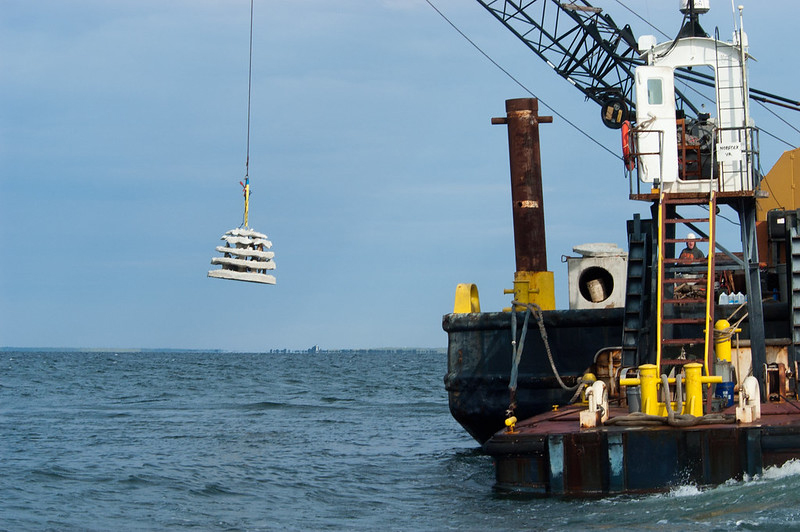The construction phase for the Florida Artificial Reef Creation and Restoration project has been completed. This project involved the Florida Fish and Wildlife Conservation Commission (FWC) coordinating with local coastal governments to deploy prefabricated artificial reef modules within permitted locations in the Gulf of Mexico, offshore of northwest Florida between Pensacola and Mexico Beach. FWC partnered with six municipalties to complete this project: Escambia, Santa Rosa, Okaloosa, Walton, and Bay counties and the City of Mexico Beach. This approximately $11.5 million project was funded with Deepwater Horizon Natural Resource Damage Assessment Phase III Early Restoration funds.
A total of 3,607 prefabricated concrete artificial reef modules were deployed across 40 permitted areas between May 2017 and February 2021. Six different types of modules were deployed. Five module types were specifically designed to provide high-quality reef fish habitat to enhance offshore fishing and diving opportunities, with the deployment of 281 large pyramids, 1,701 small pyramids, 510 ledge and disk modules (also known as grouper boxes), 397 large domes, and 25 large octahedron modules. The sixth module type was specifically designed to create new nearshore kayak fishing and snorkeling opportunities, with the deployment of 693 beach-accessible disk reefs. All modules were deployed in state waters (within 9 nautical miles from shore) at depths from 12 to 80 feet.
Following the successful deployment of the artificial reef modules, monitoring will be conducted for a minimum of 3 years at each site to evaluate recreational use and condition of the reefs as well as the species inhabiting the reefs. Generally, the reefs quickly become covered with encrusting invertebrates and macroalgae and teem with a number of different recreationally important reef fish species including red snapper, amberjack and grouper. Aside from improved catch rates for recreational anglers, modules also provide reef fish with shelter from predators, new foraging grounds and the opportunity for improved growth rates.
The goal of this project was to replace lost recreational opportunities caused by the DWH oil spill by creating new high quality reef habitats, enhanced reef fish variety and abundance, and sustainable fishing and diving opportunities for residents and visitors to northwest Florida. Enhancing reef fish habitat within state waters through large scale projects such as this increases reef fish populations within the project area and serves to disperse fishing pressure. The relatively shallow depth of these reefs also helps to improve reef fish survivability during catch-and-release activities through a reduction in barotrauma. The addition of these artificial reefs provides new locations for anglers and divers to visit and a better overall fishing and diving experience, partially restoring some of the fishing and diving impacts experienced across northwest Florida during the oil spill.
Building upon the interagency partnerships and benefits developed during this project, FWC is proposing a second phase, Florida Artificial Reef Creation and Restoration – Phase 2, in the Florida Trustee Implementation Group Draft Restoration Plan 2 and Environmental Assessment. This second phase, estimated at $10.3 million, would be implemented in both federal and state waters adjacent to Escambia, Santa Rosa, Okaloosa, Walton, Bay, Gulf, Franklin and Wakulla counties. The goal of this phase would be to provide a greater diversity of materials and locations to maximize recreational benefits across an even broader geographic range and accommodate a greater variety of marine fish species to satisfy a wider spectrum of user groups.
To find out more about FWC’s artificial reef program, including how to explore or download the Florida artificial reef map and database, visit MyFWC.com/ArtificialReefs. To find out more about DWH NRDA restoration projects in Florida, including the first and proposed second phase of the Florida Artificial Reef Creation and Restoration project, visit GulfSpillRestoration.NOAA.gov and scroll over to “Restoration Areas” on the top bar and select “Florida”.

